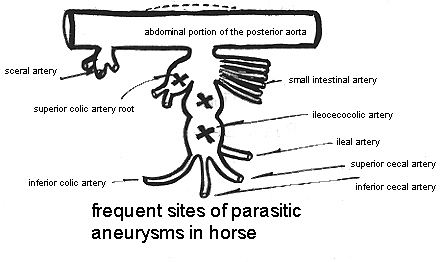Parasitic arterious aneurysm in horse


This is chronic inflammation in the arterial wall due to larvae of Strongylus vulgaris
that live in the horse large intestine. In the past, 80-95% of horses had this aneurysm.
This aneurysm is generally observed in the cranial mesenteric root artery and the roots
of its branches. The arterial wall is markedly thickened and dilated, and the intimal surface
is coarse and has thrombi that contain some - 400 larvae.
 MAJOR EXHIBITION CONTENTS
MAJOR EXHIBITION CONTENTS
 HOME
HOME
Masanobu Goryo
Address inquiries to the following.
E-Mail:goryo@iwate-u.ac.jp
Department of Veterinary Pathology, Faculty of Agriculture,
Iwate University., Morioka, 020-8550, Japan




 MAJOR EXHIBITION CONTENTS
MAJOR EXHIBITION CONTENTS
 HOME
HOME